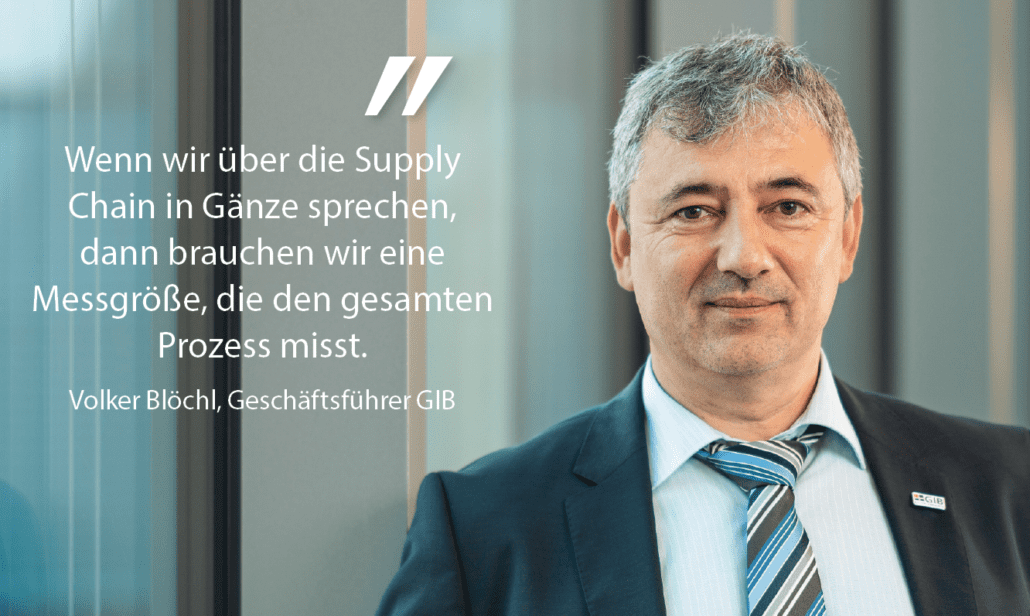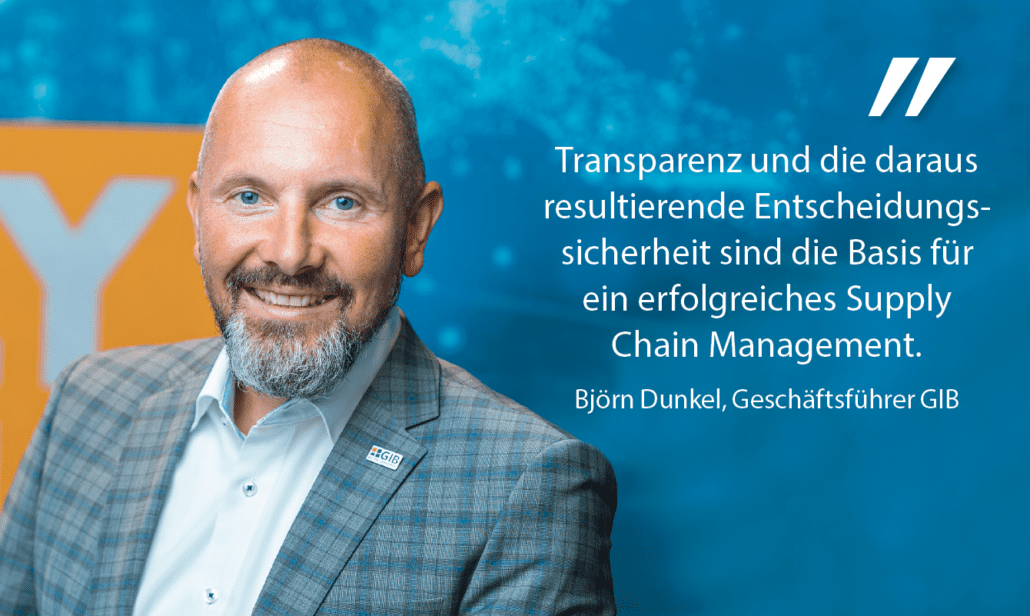Supply Chain Excellence


The requirements and challenges around logistics and supply chain include smart factory, automation, artificial intelligence and robotics. In terms of the technologies used, IT development knows no boundaries. It is an evolutionary path and not a disruptive customizing. Based on this insight, a unique SAP-based system has been developed at GIB over the past few years, which incorporates decades of knowledge from the areas of scheduling, logistics and supply chain.
Great advantages emerge from the dynamics and learning ability of GIB Supply Chain Excellence: Flexibilization, quality improvement and precision ensure an increase in performance. However, software should not replace the user, but support him. In the GIB context, the cooperation of the technical and human components plays the decisive role.
Global supply chains will continue to determine production, logistics, supply chain and distribution in the future. The various processes must be coordinated even more closely.

In order to get a grip on supply chain complexity, intelligent control of all participating users in the process chain is necessary, which requires a cooperative network structure. In addition, these value chains should be viewed holistically, which includes network-oriented management.
"Effectively building collaborative relationships continues to be seen as one of the megatrends in supply chain management implementation for the future. Coordination complexity is increasing, due to a widely advanced distribution of work and locations, internationalization up to globalization or vertical disintegration.
Especially for process synchronization, the cross-company material and information flows must be coordinated across the entire value creation process"writes Ronald Poppe, author of the book "Collaboration Platforms for Supply Chain Management." (Springer Gabler Verlag).
Who controls the supply chain better? The networked thinking human or the algorithms of GIB SCX?
"As complex as this question presents itself, the answer to it is simple."says Björn Dunkel, one of the GIB managing directors.
"The GIB supply chain excellence indicator creates problem awareness. System-immanent intelligence makes the complexity of end-to-end supply chain planning manageable."
The APEO principle, Analyze, Plan, Execute and Optimize, of GIB simplifies by addressing the right information correctly, at the right scale, in the right places at the right time: CLUI, Context based, Location based, User based Information.
"This empowers the human being to do the right things quickly and in the right priority. In this way, it remains the networked-thinking person who controls the system and thus the supply chain".explains Björn Dunkel.
The user runs through the APEO principle again and again. With the help of the software, he regularly analyzes his planning quality and can plan even more precisely in the next planning process. The simulation and saving of scenarios help to get closer to the optimal result. Only then is the planning put into practice.
The operational day-to-day business becomes clear. The goal is to provide the user with as much comfort and security as possible. The fourth and final step in the APEO principle is the optimization phase, in which actual and target are compared and the necessary steps for improvement are derived.
There are thus many positive competitions between humans and machines: In chess and Go, man has already lost, does he still master ERP and SCM?
GIB Managing Director Björn Dunkel in an E-3 interview: "ERP and SCM differ from chess and go by the fact that the one pursues in its playful core and purely for fun the task of dominating and defeating its opponent, while ERP and in particular SCM have as their goal the chaining of processes to control and plan a common success! The core of the comparison here is therefore merely IT as the lowest common denominator and in the end serves in both cases to promote people in their actions."
The actions of the ERP user are sometimes chaotic to disruptive - not intentionally, but not everyone succeeds in controlling and steering more than seven parameters. Humans tend to "repair service behavior" - if they recognize an error, they pounce on it with great commitment. It would be better to analyze the system holistically. Do you want to achieve this behavior with SCX?
"That's exactly the idea"Björn Dunkel emphasizes.
"A supply chain is only as strong as its weakest link. However, it gives us numerous warning signals before it finally breaks."
The "A" in the APEO principle stands for analysis, and Björn Dunkel explains that the GIB-SCX process indicators show the respective process maturity level: starting with the demand, manufacturing, procurement, inventory, and ending with the sales and distribution planning process.
"All these processes intertwine in a delicate way", Björn Dunkel knows from practical experience.
Book author Ronald Poppe: Increased cooperation and networking between companies is continuously being forced by both economic developments and information technology innovations. The increasing globalization enlarges the potential markets and at the same time intensifies the competition.
The increased competitive and cost pressure, combined with the dynamic change in market demand towards highly variable services with increased product complexity and diversity of variants, means that cooperative forms with their exchange relationships based on the division of labor are becoming more suitable for mastering entrepreneurial challenges.
Developments in information technology also enable and accelerate the creation and establishment of cooperative corporate networks. (Springer Gabler, ISBN 978-3-658-16369-3)

Repair service behavior
"What is the goal of any supply chain planning?"asks GIB managing director Dunkel in the E-3 interview and answers:
"To be able to serve the customer's wishes in time and quantity at 100 percent! If the sales and distribution planning process is only at 73 percent, the fault is usually in the upstream process steps. Thanks to the process indicators of the GIB SCX, the user now has a clear picture of where action is needed. Thus, he can follow his repair service behavior."
GIB SCX provides support by means of a personalized guiding function: The system shows the user in which process and at which point in the process the error occurred. SCX gives recommendations for action and opens the SAP transaction with which the error can be corrected. The whole process happens in real time based on SAP master and transaction data, which is evaluated by GIB's own heuristics.
How do you define the optimal supply chain? Volker Blöchl: "I could score points with many KPIs from the most diverse areas. Perhaps some readers would even be fascinated or impressed by how many KPIs there are. But does it really make sense to pin countless KPIs to the bulletin board and hope that this is incentive enough to bring about an improvement in supply chain processes?"
Volker Blöchl explains in an E-3 interview: "Especially when we talk about the supply chain as a whole, we need a metric that measures the entire process. This is the only way to counteract silo thinking and action. If, for example, you ask yourself what the optimum order quantity is for the company, it quickly becomes clear that an answer can only be found on a cross-functional basis. We believe that the SCX indicator, which is calculated and reported on the basis of the individual processes, provides our customers with the right view of the SCM chain.
Of course, there are companies in our customer environment that have been dealing with the optimization of the SCM chain for a long time. Many of these customers use our GIB suite to have a firm grip on processes ranging from sales planning to finite capacity planning and controlling. But I'm convinced these companies need our SCX, too, because supply chain requirements are constantly changing."
KPIs and SCX indicator
For the existing SAP customer, availability and quantity are important decision-making components: Why can't the ERP user make do with KPIs from his S/4 Hana system?
"In all modern ERP systems, we are inundated with KPIs"Volker Blöchl knows from many successful customer projects.
"If we look at the modern supply chain, we will find many KPIs in all areas. But if we ask ourselves whether we are successful, it is not enough to have a great KPI in just one section of the process chain. It is only with the linking and weighting of different KPIs that the statement becomes really exciting. Shouldn't it be our ambition to get better holistically in the process?"
Ultimately, it's all about dynamic processes and networked systems, so static state variables are of only limited help.The challenge is to optimize end-to-end processes. GIB Managing Director Volker Blöchl says:
"Understanding, designing and optimizing. This understanding is the necessary basis for being able to design and optimize. With our SCX indicator and the five process indicators, we present the current state simply and strikingly. We hold up a mirror to the SAP user.
However, we not only want to visualize the actual situation, but also guide users to the critical processes with intelligent navigation. We thus provide the strategic holistic view and operational action."
The SCX user can choose whether to navigate via the process indicators or use the process explorer, which, depending on the employee's role in the company, leads directly to the transactions that need urgent attention without any detours. Only when supply chain managers get the focus back on the process and do not waste valuable time managing the system can the optimization process start and succeed.
"Otherwise, we all remain firefighters".emphasizes Volker Blöchl, "and who wants to save the world every day? So let the systems do the work, driving our optimization in SCM."
Digital Twin
In the SAP community, the benefits and intelligence of digital twins have been discussed many times in recent years. In general, it can be said that creating a digital twin without prefabricated software components is a Sisyphean task, but hardly anyone questions the benefits of a functioning digital twin.
Now GIB Supply Chain Excellence can also be seen from the perspective of a digital twin of the digital supply chain, right? Volker Blöchl is initially surprised by the question: "I have to confess: SCX is equal to a Digital Twin - I hadn't thought of it that way. But I would definitely say yes."
The Digital Twin naturally also includes the information technology topic "Simulation of Dynamic Systems": "With regard to simulation, I would like to note that it has lost its shadowy existence with many of our customers in recent years and is now indispensable from a process perspective. What if? We have already firmly anchored this in our world for many years."explains Volker Blöchl.

Simulation and transparency
In medicine it is sometimes called the "transparent human being", would you talk about the transparent supply chain at GIB SCX?
"With the 'glass person,' I have the link to the 1982 census. That was actually the first topic that was very political for me and was discussed up and down in its entirety." recalls GIB Managing Director Volker Blöchl.
"Meanwhile, the term is also circulating quite strongly in the digital world. Especially when it comes to data protection. How much of our personal data do we want to disclose and put into other hands that do anything with it. It's hard to keep track of that, if at all."
And in relation to his own company, Volker Blöchl states:
"Yes, with our tools our customers become transparent in their supply chain. But - and this is the core - to work as efficiently as possible on their important processes and at the same time to become better and better with the gained understanding of the holistic process and through holistic optimization. And all this with feedback, using the SCX indicator to directly document the improvements."
"Transparency and the resulting decision-making reliability are the basis for successful supply chain management"Björn Dunkel emphasizes once again.
"We have led over 800 SAP supply chain projects across a wide range of industries. Based on this knowledge, we have integrated a solution into the digital core of SAP S/4 Hana that supports a best-practice end-to-end planning process."
GIB SCX is installed, adjusted to the customer's system, trained and commissioned with an effort of 50 project days. Already after installation, the GIB SCX indicator and the other process indicators can be read out.
"Thus, thanks to the highest possible transparency, we directly create an awareness of the problem, at which point the need for action is greatest. This means that every existing SAP customer can work with GIB specialists to optimize their supply chain process in a targeted manner.Björn Dunkel knows from many projects.
Cybernetics
The "helmsman's art" was a highly respected art of seafarers in ancient Greece, when it was necessary to navigate a ship safely across the sea. It is known that Odysseus was twenty years on the way, but this had other reasons. Modern cybernetics deals with the control circuits and systemic control of complex organisms and machines. Is GIB SCX a cybernetic system for SCM and logistics? Does the machine with S/4 Hana and GIB SCX master this control art today?
"I like this comparison very much indeed"says Björn Dunkel in an E-3 interview.
"At GIB, we talk about horizontal digitization. This serves to chain business processes and thus bring speed to the control of this process chain. Thanks to the architecture of an SAP S/4 Hana system, this orchestrating and bringing up speed is possible.
So in this analogy, SCX is the steering wheel. A steering wheel of the latest generation. With all the tools to navigate safely and purposefully even in storm and fog. Our software is thus the cybernetic system and the user the cyberneticist, i.e. the helmsman. We thus ensure better controllability of processes through simplification and thus make successful companies even more successful."
Expert and manager
Thus, a final question remains: Is GIB SCX the tool for the experts along the supply chain or for the strategic management of a company?
"At this point, I would like to come back to our vision: We make supply chain processes controllable".emphasizes GIB Managing Director Volker Blöchl.
"It certainly doesn't work if you don't leave the strategic altitude and roll up your sleeves!"
The great benefit of SCX lies in the combination of strategic viewpoint and user-friendly action and, of course, the interaction of both approaches.
"Our ambition is to bring exactly that to the market, reaching every user in a well-defined area, all the way to the expert who travels across all processes in the supply chain"defines Volker Blöchl.
"Our tools can be individually determined via the role definition of the users in the company. In this way, we can provide users who serve only a small area in the value chain with functions and interfaces that are completely tailored to their process tasks."
Through the intelligent SCX navigation, the employee is guided in his processes to make the right decision with the right data.
"Simple and practical, as our vision promises", emphasizes Volker Blöchl.
"Away from endless transaction calls, away from Excel evaluations that hardly anyone can keep track of, away from shadow systems like Access and others, towards effective tools. No matter what part of the supply chain we're in."






